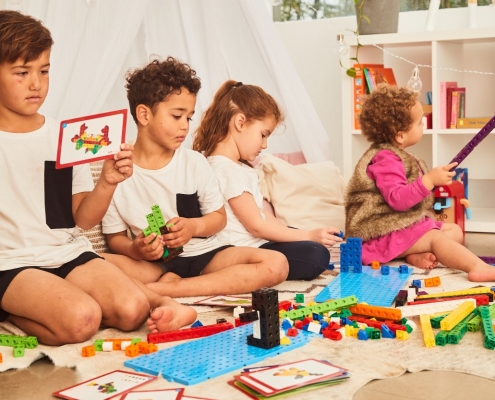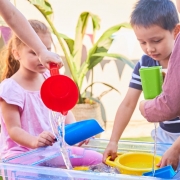Children playing with family
Keep it Simple
A mother discovers with great delight that one does not love one’s children just because they are one’s children but because of the friendship formed while raising them.” (Gabriel Garcia Marquez)
We often focus upon specific activities with children, helping them learn different skills. Whilst this is important, the best way to connect is through focusing on those little moments, or “nothing” moments, when we are just with each other and there isn’t a specific agenda. When I think back to those times that we have felt most connected in the family it has been when we are laughing, cuddling and having fun – and these don’t always involve toys. It’s less about having a fixed task and more about engaging together in activities where the process is more important than the outcome.
I had a lovely interaction with my youngest the other day, without having to set up a train track! He wanted an apple and, whilst I was inclined to cut one up and give it to him (I had lots to do) he insisted that he do the cutting. Together we made different shapes and marvelled over how different it looked without the skin. We really did connect over a piece of fruit!
The good news here is that you can playfully connect without planning. It’s just about being together and it can involve games and toys, but also include household chores. Instead of being overwhelmed by what you should be doing, think about what you already do and how you can make it more interactive.
Try to be as playful as you can – sing, makeup rhymes and do silly dances. Focus on shared activities involving eye contact and mirroring each other. I really like some of the activities that are outlined in Theraplay. This is a play therapy designed to help develop more secure attachment relationships. It focuses on activities in four different areas that help us connect with each other – nurture, engagement, challenge and structure.
The activities are simple and fun and don’t take much time (if any) to set up. They don’t need to be done in a therapy room and you can rest assured that these are tried and tested activities to help you bond with your child. If you are interested in introducing some Theraplay activities into your family then do have a look at the following list (Therapy-activities-by-Dimension.pdf (aberdeengettingitright.org.uk)) and choose some to do with your child.

Where do I find the time and energy?
“I don’t think quantity time is as special as quality time with your family.”
Rebecca McEntire
I hope by now I’ve convinced you that it’s important to spend time together as a family focusing with a focus on playing together. However, it doesn’t always feel that straightforward. Some reasons that parents have told me that it is hard to do this are:
- “I have a million other things to do – getting the children involved makes sense but they slow everything down”
- “I get a bit embarrassed and don’t really know what to do”
- “Our children are of different ages and we can’t find anything that suits the whole family”.
- “When I find the time, it’s hard to be in the moment – I’m always thinking about other things that I have to do”
- “My children don’t want to play with me – they just want to watch screens”
- “I’m just too tired…”
These are all valid reasons (many of which I have used myself) but something that you might want to consider against the importance of connecting with each other. Ask yourself, do you commit to too much? If so, does that take away quality time with your child? When you are together does your phone distract you (guilty here!)? Can you be in the moment with them or is your brain always preoccupied with other stuff? Are you including your child in helping you around the house and doing enough things together? Can you do something that everyone enjoys, regardless of age? (We often have family interviews where we pretend we are someone famous and answer questions – this is great fun for our 4-year-old as well as their 50-year-old dad!).
Sometimes a few tweaks can make the world of difference. Remember, it’s not about overhauling your life, just trying to increase those moments of connection and focus on the play that is interactive. Perhaps write a list of what you enjoyed doing with your parents when you were younger and try some of these out with your children.
We know that adults who retain immature qualities into adulthood are often more adaptable. However, we didn’t all have a playful childhood (and we often do what our parents did, even if we don’t want to!) and daily pressures can take away any inclination to play. But we all have an inner child lurking inside and sometimes we need to “fake it to make it”. It’s never too late to start connecting through play and children are probably the best people to teach you how to do this.
And what about screens? The bane of many parents’ lives can be a passive experience and source of disconnection, often ending in a “turn-it-off” argument. But they can be a good way to connect if you make them interactive. There is (some) evidence to show that playing video games together is related to family satisfaction and family closeness1. I’ve certainly found playing on screens with my increasingly teenage-like 11-year-old to be a great way to connect and enjoy each other’s company (until I lose for our team!).
When you are truly exhausted there are lots of things you can do together. I take great pleasure in lying on my bed with my son being my doctor. Of course, I can’t move until he’s tended to all my injuries (of which there are many – depending on how tired I am!).
So, try to play together as much as you can. Throw in the odd activity, be messy, imaginative and creative and have fun. And remember, it’s much less about what you do than how you do it as long as you’re in it together. Enjoy!
Posted by Dr Sarah Mundy, Consultant Clinical Psychologist and Author of Parenting Through Stories



